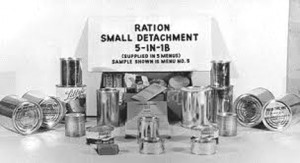 The conversation around the table of the Duncan T. Trueman Chapter 59 at the November meeting turned to those delicious meals we were served on Thanksgiving day in ’45, and so I include here a brief listing of what the Army supposedly fed us. According to the Stars and Stripes, every man, woman, and even that Sergeant they had to keep muzzled and on a leash, was fed a full Thanksgiving dinner, complete with turkey and all the fixings. It was supposed to be true, but I’ve run into a couple of guys who said that was just some Rear Echelon Commando’s pipe dream! I know that I had mine with everything piled up together on a steel tray, which I ate standing at a mess table welded to the deck on the USS Monicello, a Navy transport, on my way to England.
The conversation around the table of the Duncan T. Trueman Chapter 59 at the November meeting turned to those delicious meals we were served on Thanksgiving day in ’45, and so I include here a brief listing of what the Army supposedly fed us. According to the Stars and Stripes, every man, woman, and even that Sergeant they had to keep muzzled and on a leash, was fed a full Thanksgiving dinner, complete with turkey and all the fixings. It was supposed to be true, but I’ve run into a couple of guys who said that was just some Rear Echelon Commando’s pipe dream! I know that I had mine with everything piled up together on a steel tray, which I ate standing at a mess table welded to the deck on the USS Monicello, a Navy transport, on my way to England.
When it could, the Army really did try to do well by us, an effort which unfortunately some Mess Sergeants and Army cooks managed to mess up. First was the “A” ration, which included all fresh food. Then came the “B” ration, which included canned or otherwise preserved food items. No need to describe the C-Ration – Dog food in two small cans! The D-Ration was that high energy bar of chocolate and cereal, which could be melted to produce a pretty good beverage if your canteen cup could stand the heat from the wood fire,or that little stove-in-a-can (if you were lucky enough to have one) or cooked up with those crackers to make something resembling chocolate pudding. The K-ration was more dog food, in a GI Cracker Jack box. Finally there was what I personally consider the best of the field rations offered to us in combat, the 10-in-l Small Detachment Ration, commonly referred to as the 10-in-l.
The 10-in-l Small Detachment Ration consisted of one 5-in-lA and one 5-in-lB unit, and was composed of 5 menus, varying between 8500 and 4050 calories and supplying between 91 and 121 grams of protein. The vitamin and mineral content was slightly below requirements, and the ration weighed 5 more pounds than specifications called for.
The full day’s rations were divided into two sets of two cartons, each set with food for five men so it could feed ten men for a day or five men for two days (or even one man for ten days). The four cartons were placed into a larger packing carton. Each separate carton contained one of five different menus containing a wide variety of canned food and accessory items such as cigarettes, matches, P38 can openers, toilet tissue, soap, and paper towels.
A typical menu follows:
Breakfast: Cereal, Sliced Pineapple, Pork Sausage, Crackers with Jam, Coffee, Milk, and Sugar.
Dinner: Luncheon Meat (AKA Spam), Cheese, Crackers, Fig Pudding or Fruit Cake, Cocoa, Chocolate Bar ID Ration).
Supper: Spaghetti and Meat Balls, Peas, Crackers with Army Spread (Canned Butter), Coffee, Milk and Sugar, Caramel Nougat Bar, Peanuts.
Water purification tablets were included to purify drinking water.
